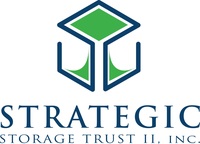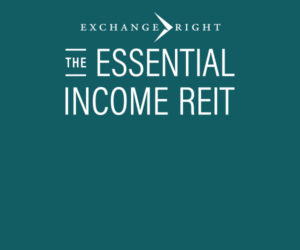Strategic Storage Trust II, Inc. Reports 2017 First Quarter Results
May 17, 2017 | Strategic Storage Trust II, Inc.

LADERA RANCH, Calif., May 17, 2017 /PRNewswire/ — Strategic Storage Trust II, Inc. (“SST II”) announced strong increases in same-store revenues, net operating income (“NOI”), occupancy and annualized rent per square footage as part of its overall operating results for the three months ended March 31, 2017.
“Our first quarter same-store results show the execution of our strategy: acquiring quality assets in strong markets and recognizing greater revenues as the properties stabilize,” said H. Michael Schwartz, chairman and chief executive officer of SST II. “Our approach continues in 2017, with the acquisitions made in the past 12 months improving the operating results of the entire portfolio.”
First Quarter 2017 Highlights
Increased total revenue by approximately $11.5 million, or 184%, when compared to the same period in 2016.
Increased same-store revenues and NOI by 15.6% and 32.2%, respectively, compared to the same period in 2016.
Increased same-store average physical occupancy by approximately 8.1% to 92.3% from 84.2% compared to the same period in 2016.
Increased same-store annualized rent per occupied square foot by approximately 5.5% to $13.29 from $12.60 compared to the same period in 2016.
Increased modified funds from operations by approximately $2.1 million, or 130%, when compared to the same period in 2016.
Acquisitions
Aurora II Property
On January 11, 2017, SST II closed on a self storage facility located in Aurora, Colorado. The Aurora property was acquired for a purchase price of approximately $10.1 million. The property has approximately 400 units and approximately 53,400 rentable square feet.
Toronto Five Property Portfolio Merger
On February 1, 2017, SST II entered into a merger agreement with Strategic Storage Toronto Properties REIT, Inc., an affiliate of its sponsor, in which SST II acquired five self storage properties located in the Greater Toronto Areas of North York, Mississauga, Brampton, Pickering and Scarborough (the “Toronto Merger”), and assumed property loans and other existing debt. Each property is operated under the “SmartStop” brand. Through the Toronto Merger, each Strategic Storage Toronto Properties REIT, Inc. common stock share was automatically converted into the right to receive $11.0651 USD in cash and 0.7311 Class A Units of SST II’s operating partnership. SST II paid an aggregate of approximately $7.3 million USD in cash and issued an aggregate of approximately 483,197 Class A Units of its operating partnership to the common stockholders of Strategic Storage Toronto Properties REIT, Inc. The properties have approximately 4,010 units and approximately 460,400 rentable square feet.
Closedown of Offering
On January 9, 2017, SST II terminated its primary offering. On November 30, 2016, SST II filed with the SEC a Registration Statement on Form S-3, which incorporated its distribution reinvestment plan (the “DRP Offering”) and registered up to an additional $100.9 million in shares under its DRP Offering. The DRP Offering may be terminated at any time upon 10 days’ prior written notice to stockholders.
Equity Raise
As of March 31, 2017, SST II had issued approximately 49 million Class A Shares and approximately 7 million Class T Shares for approximately $497 million and $73 million, respectively, in its offerings, including its DRP Offering.
Quarterly Dividend
On March 21, 2017, the board of directors of SST II declared a distribution rate for the second quarter of 2017 of approximately $0.001644 per day per share on the outstanding shares of common stock payable to both Class A and Class T stockholders of record of such shares as shown on its books at the close of business on each day during the period commencing on April 1, 2017 and continuing on each day thereafter through and including June 30, 2017. Such distributions payable to each stockholder of record during a month will be paid the following month.
Subsequent Events
Updated NAV
On April 13, 2017, the board of directors of SST II, upon recommendation of its nominating and corporate governance committee, approved an estimated value per share of its common stock of $10.22 for its Class A Shares and Class T Shares based on the estimated value of SST II’s assets less the estimated value of its liabilities, or net asset value, divided by the number of shares outstanding on a fully diluted basis, calculated as of December 31, 2016. See SST II’s Current Report on Form 8-K filed with the SEC on April 18, 2017 for a description of the methodologies and assumptions used to determine, and the limitations of, the estimated value per share.
KeyBank Florida CMBS Loan
On April 11, 2017, SST II refinanced its amended property loan with KeyBank National Association (“KeyBank”), and placed the five Florida properties encumbered by the loan onto a $52 million, 10 year loan with KeyBank. The loan matures on May 1, 2027 and monthly payments due under the loan are interest-only for the first five years, with payments reflecting a 30-year amortization schedule beginning thereafter. The loan bears interest at 4.65%.
Interest Rate Cap
On May 1, 2017, SST II purchased an interest rate cap with a notional amount of $90 million, such that as of the effective date of July 1, 2017, LIBOR is capped at 1.25% through December 22, 2018.
|
STRATEGIC STORAGE TRUST II, INC. AND SUBSIDIARIES |
||
|
CONSOLIDATED BALANCE SHEETS |
||
|
March 31, |
December 31, |
|
|
ASSETS |
||
|
Real estate facilities: |
||
|
Land |
$270,258,082 |
$249,051,278 |
|
Buildings |
506,122,092 |
439,426,157 |
|
Site improvements |
42,321,305 |
38,978,298 |
|
818,701,479 |
727,455,733 |
|
|
Accumulated depreciation |
(19,601,857 ) |
(14,855,188 ) |
|
799,099,622 |
712,600,545 |
|
|
Construction in process |
334,757 |
1,740,139 |
|
Real estate facilities, net |
799,434,379 |
714,340,684 |
|
Cash and cash equivalents |
11,581,497 |
14,993,869 |
|
Restricted cash |
3,710,903 |
3,040,936 |
|
Other assets |
5,438,305 |
5,533,182 |
|
Debt issuance costs, net of accumulated amortization |
1,768,155 |
1,550,410 |
|
Intangible assets, net of accumulated amortization |
13,726,302 |
13,094,530 |
|
Total assets |
$835,659,541 |
$752,553,611 |
|
LIABILITIES AND EQUITY |
||
|
Debt, net |
$389,977,293 |
$320,820,740 |
|
Accounts payable and accrued liabilities |
8,047,606 |
4,601,422 |
|
Due to affiliates |
3,180,465 |
3,178,235 |
|
Distributions payable |
2,800,701 |
2,608,609 |
|
Total liabilities |
404,006,065 |
331,209,006 |
|
Commitments and contingencies |
||
|
Redeemable common stock |
14,194,453 |
10,711,682 |
|
Equity: |
||
|
Strategic Storage Trust II, Inc. equity: |
||
|
Preferred stock, $0.001 par value; 200,000,000 shares authorized; none issued and outstanding at March 31, 2017 and December 31, 2016 |
— |
— |
|
Class A common stock, $0.001 par value; 350,000,000 shares authorized; 48,506,002 and 47,174,543 shares issued and outstanding at March 31, 2017 and December 31, 2016, respectively |
48,506 |
47,174 |
|
Class T common stock, $0.001 par value; 350,000,000 shares authorized; 7,198,180 and 6,585,799 shares issued and outstanding at March 31, 2017 and December 31, 2016, respectively |
7,198 |
6,586 |
|
Additional paid-in capital |
496,174,563 |
480,692,731 |
|
Distributions |
(35,689,365 ) |
(27,665,337 ) |
|
Accumulated deficit |
(48,968,825 ) |
(43,777,711 ) |
|
Accumulated other comprehensive income |
1,140,152 |
1,377,950 |
|
Total Strategic Storage Trust II, Inc. equity |
412,712,229 |
410,681,393 |
|
Total equity |
417,459,023 |
410,632,923 |
|
Total liabilities and equity |
$835,659,541 |
$752,553,611 |
|
STRATEGIC STORAGE TRUST II, INC. AND SUBSIDIARIES |
||
|
CONSOLIDATED STATEMENTS OF OPERATIONS |
||
|
(Unaudited) |
||
|
Three Months Ended |
||
|
2017 |
2016 |
|
|
Revenues: |
||
|
Self storage rental revenue |
$ 17,612,186 |
$ 6,196,842 |
|
Ancillary operating revenue |
95,360 |
37,747 |
|
Total revenues |
17,707,546 |
6,234,589 |
|
Operating expenses: |
||
|
Property operating expenses |
5,937,345 |
2,496,864 |
|
Property operating expenses – affiliates |
2,358,997 |
701,309 |
|
General and administrative |
995,913 |
694,768 |
|
Depreciation |
4,774,432 |
1,457,284 |
|
Intangible amortization expense |
3,714,656 |
1,854,765 |
|
Acquisition expenses—affiliates |
212,577 |
1,623,205 |
|
Other property acquisition expenses |
265,763 |
1,220,731 |
|
Total operating expenses |
18,259,683 |
10,048,926 |
|
Operating loss |
(552,137 ) |
(3,814,337 ) |
|
Other income (expense): |
||
|
Interest expense |
(3,564,304 ) |
(482,207 ) |
|
Interest expense—accretion of fair market value of secured debt |
8,634 |
35,726 |
|
Interest expense—debt issuance costs |
(1,029,326 ) |
(218,108 ) |
|
Other |
(84,347 ) |
(29,728 ) |
|
Net loss |
(5,221,480 ) |
(4,508,654 ) |
|
Net loss attributable to the noncontrolling interests in our Operating Partnership |
30,366 |
3,450 |
|
Net loss attributable to Strategic Storage Trust II, Inc. common stockholders |
$ (5,191,114 ) |
$ (4,505,204 ) |
|
Net loss per Class A share – basic and diluted |
$ (0.09 ) |
$ (0.17 ) |
|
Net loss per Class T share – basic and diluted |
$ (0.09 ) |
$ (0.17 ) |
|
Weighted average Class A shares outstanding – basic and diluted |
48,261,978 |
25,081,631 |
|
Weighted average Class T shares outstanding – basic and diluted |
7,139,168 |
1,037,718 |
|
STRATEGIC STORAGE TRUST II, INC. AND SUBSIDIARIES |
||
|
NON-GAAP MEASURE – COMPUTATION OF MODIFIED FUNDS FROM OPERATIONS |
||
|
(Unaudited) |
||
|
Three Months |
Three Months |
|
|
Net loss attributable to Strategic Storage Trust II, Inc. common stockholders |
$ (5,191,114 ) |
$ (4,505,204 ) |
|
Add: |
||
|
Depreciation |
4,740,246 |
1,445,071 |
|
Amortization of intangible assets |
3,714,656 |
1,854,765 |
|
Deduct: |
||
|
Adjustment for noncontrolling interests |
(53,631 ) |
(2,512 ) |
|
FFO |
3,210,157 |
(1,207,880 ) |
|
Other Adjustments: |
||
|
Acquisition expenses(1) |
478,340 |
2,843,936 |
|
Accretion of fair market value of secured debt(2) |
(8,634 ) |
(35,726 ) |
|
Adjustment for noncontrolling interests |
(1,239 ) |
(3,496 ) |
|
MFFO |
$ 3,678,624 |
$ 1,596,834 |
(1) In evaluating investments in real estate, SST II differentiates the costs to acquire the investment from the operations derived from the investment. Such information would be comparable only for publicly registered, non-traded REITs that have generally completed their acquisition activity and have other similar operating characteristics. By excluding expensed acquisition related expenses, SST II believes MFFO provides useful supplemental information that is comparable for each type of real estate investment and is consistent with management’s analysis of the investing and operating performance of its properties. Acquisition fees and expenses include payments to SST II’s advisor and third parties. Acquisition related expenses under GAAP are considered operating expenses and as expenses included in the determination of net income (loss) and income (loss) from continuing operations, both of which are performance measures under GAAP. All paid and accrued acquisition fees and expenses will have negative effects on returns to investors, the potential for future distributions, and cash flows generated by SST II, unless earnings from operations or net sales proceeds from the disposition of other properties are generated to cover the purchase price of the property, these fees and expenses and other costs related to such property.
(2) This represents the difference between the stated interest rate and the estimated market interest rate on assumed notes as of the date of acquisition. Such amounts have been excluded from MFFO because SST II believes MFFO provides useful supplementary information by focusing on operating fundamentals, rather than events not related to its normal operations. SST II is responsible for managing interest rate risk and does not rely on another party to manage such risk.
ADDITIONAL INFORMATION REGARDING NOI, FFO, and MFFO
Net Operating Income (“NOI”)
NOI is a non-GAAP measure that SST II defines as net income (loss), computed in accordance with GAAP, generated from properties before corporate general and administrative expenses, asset management fees, interest expense, depreciation, amortization, acquisition expenses and other non-property related expenses. SST II believes that NOI is useful for investors as it provides a measure of the operating performance of its operating assets because NOI excludes certain items that are not associated with the operation of the properties. Additionally, SST II believes that NOI is a widely accepted measure of comparative operating performance in the real estate community. However, SST II’s use of the term NOI may not be comparable to that of other real estate companies as they may have different methodologies for computing this amount.
Funds from Operations (“FFO”) and Modified Funds from Operations (“MFFO”)
Due to certain unique operating characteristics of real estate companies, the National Association of Real Estate Investment Trusts, or NAREIT, an industry trade group, has promulgated a measure known as funds from operations, or FFO, which SST II believes to be an appropriate supplemental measure to reflect the operating performance of a REIT. The use of FFO is recommended by the REIT industry as a supplemental performance measure. FFO is not equivalent to SST II’s net income (loss) as determined under GAAP.
SST II defines FFO, a non-GAAP measure, consistent with the standards established by the White Paper on FFO approved by the Board of Governors of NAREIT, as revised in February 2004, or the White Paper. The White Paper defines FFO as net income (loss) computed in accordance with GAAP, excluding gains or losses from sales of property and asset impairment write downs, plus depreciation and amortization, and after adjustments for unconsolidated partnerships and joint ventures. Adjustments for unconsolidated partnerships and joint ventures are calculated to reflect FFO on the same basis. SST II’s FFO calculation complies with NAREIT’s policy described above.
The historical accounting convention used for real estate assets requires straight-line depreciation of buildings and improvements, which implies that the value of real estate assets diminishes predictably over time. Diminution in value may occur if such assets are not adequately maintained or repaired and renovated as required by relevant circumstances or other measures necessary to maintain the assets are not undertaken. However, SST II believes that, since real estate values historically rise and fall with market conditions, including inflation, interest rates, the business cycle, unemployment and consumer spending, presentations of operating results for a REIT using historical accounting for depreciation may be less informative. In addition, in the determination of FFO, SST II believes it is appropriate to disregard impairment charges, as this is a fair value adjustment that is largely based on market fluctuations and assessments regarding general market conditions which can change over time. An asset will only be evaluated for impairment if certain impairment indications exist and if the carrying value, or book value, exceeds the total estimated undiscounted future cash flows (including net rental revenues, net proceeds on the sale of the property, and any other ancillary cash flows at a property or group level under GAAP) from such asset. Testing for impairment is a continuous process and is analyzed on a quarterly basis. Investors should note, however, that determinations of whether impairment charges have been incurred are based partly on anticipated operating performance, because estimated undiscounted future cash flows from a property, including estimated future net rental revenues, net proceeds on the sale of the property, and certain other ancillary cash flows, are taken into account in determining whether an impairment charge has been incurred. While impairment charges are excluded from the calculation of FFO as described above, investors are cautioned that due to the fact that impairments are based on estimated future undiscounted cash flows and that SST II intends to have a relatively limited term of its operations; it could be difficult to recover any impairment charges through the eventual sale of the property. To date, SST II has not recognized any impairments.
Historical accounting for real estate involves the use of GAAP. Any other method of accounting for real estate such as the fair value method cannot be construed to be any more accurate or relevant than the comparable methodologies of real estate valuation found in GAAP. Nevertheless, SST II believes that the use of FFO, which excludes the impact of real estate related depreciation and amortization and impairments, assists in providing a more complete understanding of its performance to investors and to its management, and when compared year over year, reflects the impact on SST II’s operations from trends in occupancy rates, rental rates, operating costs, general and administrative expenses, and interest costs, which may not be immediately apparent from net income (loss).
However, FFO or modified funds from operations (“MFFO”), discussed below, should not be construed to be more relevant or accurate than the current GAAP methodology in calculating net income (loss) or in its applicability in evaluating SST II’s operating performance. The method utilized to evaluate the value and performance of real estate under GAAP should be considered a more relevant measure of operational performance and is, therefore, given more prominence than the non-GAAP FFO and MFFO measures and the adjustments to GAAP in calculating FFO and MFFO.
Changes in the accounting and reporting rules under GAAP that were put into effect and other changes to GAAP accounting for real estate subsequent to the establishment of NAREIT’s definition of FFO have prompted an increase in cash-settled expenses, specifically acquisition fees and expenses, that are expensed as operating expenses under GAAP. SST II believes these fees and expenses do not affect its overall long-term operating performance. Publicly registered, non-traded REITs typically have a significant amount of acquisition activity and are substantially more dynamic during their initial years of investment and operation. The purchase of properties, and the corresponding expenses associated with that process, is a key feature of SST II’s business plan in order to generate operational income and cash flow in order to make distributions to investors. While other start-up entities may also experience significant acquisition activity during their initial years, SST II believes that publicly registered, non-traded REITs are unique in that they typically have a limited life with targeted exit strategies within a relatively limited time frame after the acquisition activity ceases. As disclosed in the prospectus for SST II’s offering, SST II will use the proceeds raised in its offering to acquire properties and SST II expects to begin the process of achieving a liquidity event (i.e., listing of its shares of common stock on a national securities exchange, a merger or sale, the sale of all or substantially all of its assets, or another similar transaction) within three to five years after the completion of its offering, which is generally comparable to other publicly registered, non-traded REITs. Thus, SST II does not intend to continuously purchase assets and intends to have a limited life. The decision whether to engage in any liquidity event is in the sole discretion of the board of directors of SST II. Due to the above factors and other unique features of publicly registered, non-traded REITs, the Investment Program Association, or the IPA, an industry trade group, has standardized a measure known as MFFO, which the IPA has recommended as a supplemental measure for publicly registered, non-traded REITs and which SST II believes to be another appropriate supplemental measure to reflect the operating performance of a publicly registered, non-traded REIT having the characteristics described above. MFFO is not equivalent to SST II’s net income (loss) as determined under GAAP, and MFFO may not be a useful measure of the impact of long-term operating performance on value if SST II does not ultimately engage in a liquidity event. SST II believes that, because MFFO excludes acquisition fees and expenses that affect its operations only in periods in which properties are acquired and that SST II considers more reflective of investing activities, as well as other non-operating items included in FFO, MFFO can provide, on a going-forward basis, an indication of the sustainability (that is, the capacity to continue to be maintained) of SST II’s operating performance after the period in which it is acquiring properties and once its portfolio is in place. By providing MFFO, SST II believes it is presenting useful information that assists investors and analysts to better assess the sustainability of its operating performance after its offering has been completed and its properties have been acquired. SST II also believes that MFFO is a recognized measure of sustainable operating performance by the publicly registered, non-traded REIT industry. Further, SST II believes MFFO is useful in comparing the sustainability of its operating performance after its offering and acquisitions are completed with the sustainability of the operating performance of other real estate companies that are not as involved in acquisition activities. Investors are cautioned that MFFO should only be used to assess the sustainability of SST II’s operating performance after its offering has been completed and properties have been acquired, as it excludes acquisition fees and expenses that have a negative effect on SST II’s operating performance during the periods in which properties are acquired.
SST II defines MFFO, a non-GAAP measure, consistent with the IPA’s Guideline 2010-01, Supplemental Performance Measure for Publicly Registered, Non-Listed REITs: Modified Funds From Operations (the “Practice Guideline”) issued by the IPA in November 2010. The Practice Guideline defines MFFO as FFO further adjusted for the following items included in the determination of GAAP net income (loss): acquisition fees and expenses; amounts relating to straight line rents and amortization of above or below intangible lease assets and liabilities; accretion of discounts and amortization of premiums on debt investments; non-recurring impairments of real estate related investments; mark-to-market adjustments included in net income; non-recurring gains or losses included in net income from the extinguishment or sale of debt, hedges, foreign exchange, derivatives or securities holdings where trading of such holdings is not a fundamental attribute of the business plan, unrealized gains or losses resulting from consolidation from, or deconsolidation to, equity accounting, adjustments relating to contingent purchase price obligations included in net income, and after adjustments for consolidated and unconsolidated partnerships and joint ventures, with such adjustments calculated to reflect MFFO on the same basis. The accretion of discounts and amortization of premiums on debt investments, unrealized gains and losses on hedges, foreign exchange, derivatives or securities holdings, unrealized gains and losses resulting from consolidations, as well as other listed cash flow adjustments are adjustments made to net income (loss) in calculating cash flows from operations and, in some cases, reflect gains or losses which are unrealized and may not ultimately be realized.
SST II’s MFFO calculation complies with the IPA’s Practice Guideline described above. In calculating MFFO, SST II excludes acquisition related expenses, the amortization of fair value adjustments related to debt, realized and unrealized gains and losses on foreign exchange holdings and the adjustments of such items related to non-controlling interests. The other adjustments included in the IPA’s Practice Guideline are not applicable to SST II for the periods presented. Acquisition fees and expenses are paid in cash by SST II, and it has not set aside or put into escrow any specific amount of proceeds from its offering to be used to fund acquisition fees and expenses. SST II does not intend to fund acquisition fees and expenses in the future from operating revenues and cash flows, nor from the sale of properties and subsequent re-deployment of capital and concurrent incurring of acquisition fees and expenses. Acquisition fees and expenses include payments to SST II’s advisor and third parties. Acquisition related expenses under GAAP are considered operating expenses and as expenses included in the determination of net income (loss) and income (loss) from continuing operations, both of which are performance measures under GAAP. All paid and accrued acquisition fees and expenses will have negative effects on returns to investors, the potential for future distributions, and cash flows generated by SST II, unless earnings from operations or net sales proceeds from the disposition of other properties are generated to cover the purchase price of the property, these fees and expenses and other costs related to such property. In the future, if SST II is not able to raise additional proceeds from its offering, this could result in SST II paying acquisition fees or reimbursing acquisition expenses due to its advisor, or a portion thereof, with net proceeds from borrowed funds, operational earnings or cash flows, net proceeds from the sale of properties, or ancillary cash flows. As a result, the amount of proceeds available for investment and operations would be reduced, or SST II may incur additional interest expense as a result of borrowed funds.
Further, under GAAP, certain contemplated non-cash fair value and other non-cash adjustments are considered operating non-cash adjustments to net income (loss) in determining cash flows from operations. In addition, SST II views fair value adjustments of derivatives and the amortization of fair value adjustments related to debt as items which are unrealized and may not ultimately be realized or as items which are not reflective of on-going operations and are therefore typically adjusted for when assessing operating performance.
SST II uses MFFO and the adjustments used to calculate it in order to evaluate its performance against other publicly registered, non-traded REITs which intend to have limited lives with short and defined acquisition periods and targeted exit strategies shortly thereafter. As noted above, MFFO may not be a useful measure of the impact of long-term operating performance if SST II does not continue to operate in this manner. SST II believes that its use of MFFO and the adjustments used to calculate it allow it to present its performance in a manner that reflects certain characteristics that are unique to publicly registered, non-traded REITs, such as their limited life, limited and defined acquisition period and targeted exit strategy, and hence that the use of such measures may be useful to investors. For example, acquisition fees and expenses are intended to be funded from the proceeds of SST II’s offering and other financing sources and not from operations. By excluding expensed acquisition fees and expenses, the use of MFFO provides information consistent with management’s analysis of the operating performance of the properties. Additionally, fair value adjustments, which are based on the impact of current market fluctuations and underlying assessments of general market conditions, but can also result from operational factors such as rental and occupancy rates, may not be directly related or attributable to SST II’s current operating performance. By excluding such charges that may reflect anticipated and unrealized gains or losses, SST II believes MFFO provides useful supplemental information.
Presentation of this information is intended to provide useful information to investors as they compare the operating performance of different REITs, although it should be noted that not all REITs calculate FFO and MFFO the same way, so comparisons with other REITs may not be meaningful. Furthermore, FFO and MFFO are not necessarily indicative of cash flow available to fund cash needs and should not be considered as an alternative to net income (loss) or income (loss) from continuing operations as an indication of SST II’s performance, as an alternative to cash flows from operations, which is an indication of SST II’s liquidity, or indicative of funds available to fund SST II’s cash needs including its ability to make distributions to its stockholders. FFO and MFFO should be reviewed in conjunction with other measurements as an indication of SST II’s performance. MFFO may be useful in assisting management and investors in assessing the sustainability of operating performance in future operating periods, and in particular, after the offering and acquisition stages are complete.
Neither the SEC, NAREIT, nor any other regulatory body has passed judgment on the acceptability of the adjustments that SST II uses to calculate FFO or MFFO. In the future, the SEC, NAREIT or another regulatory body may decide to standardize the allowable adjustments across the publicly registered, non-traded REIT industry and SST II would have to adjust its calculation and characterization of FFO or MFFO.
About Strategic Storage Trust II, Inc. (“SST II”):
SST II is a public non-traded REIT that focuses on stabilized self storage properties. The SST II portfolio currently consists of 83 self storage facilities located in 14 states and Ontario, Canada, comprising approximately 51,300 self storage units and approximately 6.0 million net rentable square feet of storage space.
About SmartStop Asset Management, LLC (“SmartStop”):
SmartStop is a diversified real estate company focused on self storage assets, along with student and senior housing. SmartStop has a managed portfolio that currently includes approximately 68,000 self storage units and approximately 7.8 million rentable square feet and approximately $1.1 billion of real estate assets under management. SmartStop is the asset manager for 107 self storage facilities located throughout the United States and Toronto, Canada and one student housing facility. SmartStop is the sponsor of SST II, Strategic Storage Growth Trust, Inc., and Strategic Storage Trust IV, Inc., all public non-traded REITs focusing on self storage assets. The facilities offer affordable and accessible storage units for residential and commercial customers. In addition, they offer secure interior and exterior storage units as well as outside storage areas for vehicles, RVs and boats. Additional information is available at www.smartstopassetmanagement.com.
This press release may contain certain forward-looking statements within the meaning of Section 27A of the Securities Act of 1933, as amended, and Section 21E of the Securities Exchange Act of 1934, as amended. Such forward-looking statements can generally be identified by our use of forward-looking terminology such as “may,” “will,” “expect,” “intend,” “anticipate,” “estimate,” “believe,” “continue,” or other similar words. Because such statements include risks, uncertainties and contingencies, actual results may differ materially from the expectations, intentions, beliefs, plans or predictions of the future expressed or implied by such forward-looking statements. These risks, uncertainties and contingencies include, but are not limited to: uncertainties relating to changes in general economic and real estate conditions; uncertainties relating to the implementation of our real estate investment strategy; uncertainties relating to financing availability and capital proceeds; uncertainties relating to the closing of property acquisitions; uncertainties related to the timing and availability of distributions; and other risk factors as outlined in the Company’s public filings with the Securities and Exchange Commission. This is neither an offer nor a solicitation to purchase securities.











